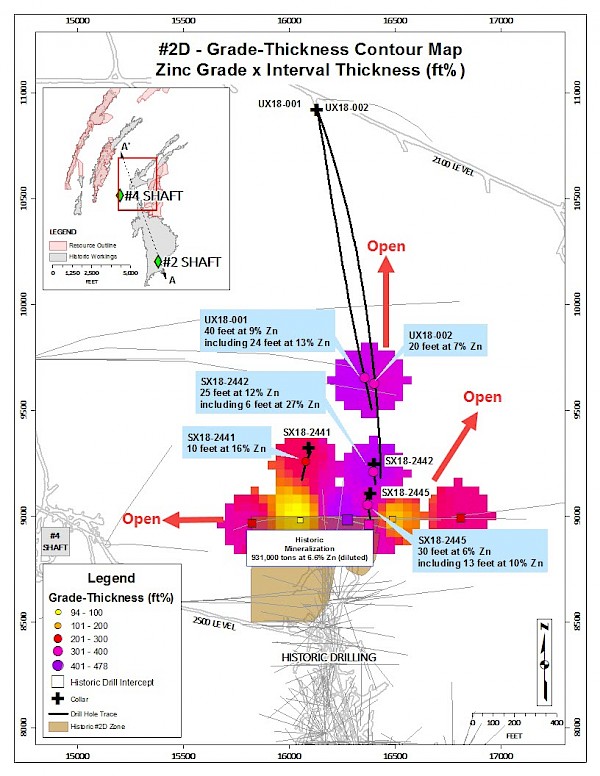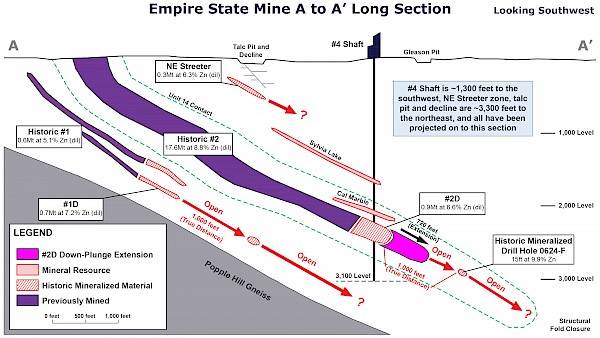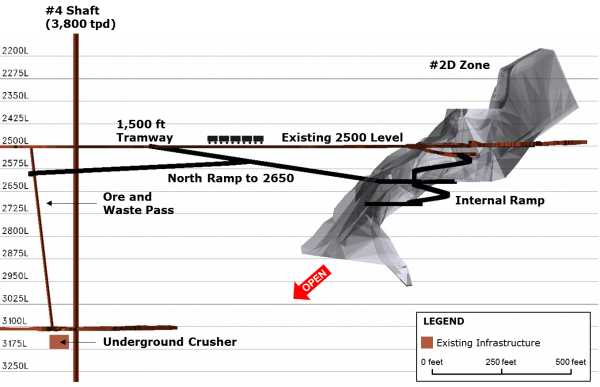Titan Mining Announces Major Expansion of Historic Mineralized Zone Close to the Shaft at Empire State Mine and Provides Operational Update
Vancouver, B.C., November 14, 2018 – Titan Mining Corporation (TSX:TI) (“Titan” or the “Company”) today provided an update on the operations and exploration program at its Empire State Mine (“ESM”). All financial amounts are in U.S. dollars, unless otherwise stated.
Highlights
- Titan’s executive leadership team was strengthened with the appointment of Donald Taylor as Chief Executive Officer, Purni Parikh as President and Kevin Torpy as VP, Operations.
- The Board of Directors was enhanced with the addition of John Boehner, James Gowans and William Mulrow, bringing further mining and financial expertise to the Board.
- Drilling has resulted in a major high-grade expansion of the near-mine #2D zone, formerly referred to as #2 Deep, by over 700 feet down-plunge. The zone remains open at depth and laterally toward the #4 shaft. Development of this zone will be a focus in the short term. A definition drilling program is planned for the fourth quarter of 2018, and preliminary engineering design is underway.
- An updated mine plan for ESM, incorporating the #2D zone, is expected in the first half of 2019.
- Production at ESM was impacted in the third quarter of 2018 mainly by low productivity from the mining contractor, however, payable zinc shipments increased by 6% from the prior quarter.
- The transition from contractor to owner-mining has been completed and 190 of 200 staff positions at ESM have been filled to date.
- Titan has received a commitment for the financing of its operations into 2019.
Donald Taylor, Chief Executive Officer of Titan, commented: “We faced some set-backs in the ramp up at ESM. Production rates in the third quarter were impacted by a hoist incident and overall underperformance by our mining contractor. New mine management is in place and immediate changes have been implemented to address this short-term issue. The transition from contractor to owner-mining was accelerated and completed before the end of October. I believe the quick decisions today will set us up for a successful 2019 and beyond as we target near-mine growth opportunities to maximize production, given our available spare capacity.”
“The #2D zone, an extension of the large #2 mine which accounted for about half of the tons mined historically at ESM, is growing rapidly,” continued Mr. Taylor. “This zone has the potential to add significant high-grade tonnage to the mine plan, with low capital costs given its proximity to the existing #4 shaft and historic infrastructure. We plan to complete an updated mine plan in the first half of 2019 that is expected to incorporate these lower-risk tons from the #2D zone and reflect production levels well beyond the company's previous 1,800 tons-per-day run-rate target.”
Richard Warke, Executive Chairman of Titan, has committed to finance the Company’s operations into 2019.
Richard Warke stated, “With our new leadership in place, I am confident in ESM’s long-term growth prospects. The mine was purchased with the belief there would be numerous large, high-grade orebodies found in this prolific zinc district, and I am very pleased that #2D has been identified and expanded so quickly. It could be a game changer. The Augusta Group has had great success over the years by identifying projects that have been overlooked in the market and adding value through new exploration, studies and approaches to development. With the addition of Don Taylor as CEO and the experience he brings, Titan will undoubtably have an exciting future.”
Operations Review
In the third quarter of 2018, mine ore production of 57,544 tons was 11% lower than in the prior quarter, however, milled grade was 9.0% zinc and concentrate grade was 59.7% zinc, demonstrating effective grade control. Zinc concentrate production was 8,816 tons, a 7% increase from the prior quarter, reflecting higher average feed grade and high mill recovery of 96.1%. Payable zinc shipments totaled 9.4 million pounds, an increase of 6% from the prior quarter.
Production at ESM was impacted by a number of operational issues in the third quarter. In late July, a hoist incident occurred following which underground activities were suspended for six days. The cause of the incident was electrical in nature, and corrective action was taken. ESM experienced lower development and production rates than anticipated due to underperformance of the mining contractor, which impacted the overall level of productivity. The mine is expected to benefit from the transition to owner-mining which was completed in October. Recruiting efforts associated with the transition have been progressing well. There are 10 positions remaining to be filled in order to reach the current target staffing level of 200.
Major Expansion of Historic Mineralized Zone at ESM #2 Mine
Successful exploration drilling has extended the previously identified mineralization in the #2D zone at ESM (see News Release dated June 12, 2018). The exploration drill holes highlighted in this news release are step-out holes from the unmined historic #2D mineralized zone, confirming the presence of robust mineralization down-plunge to the north-northeast of the historic #2 mine. Multiple mineralized horizons (#2D Upper and #2D Lower) were intercepted, demonstrating the continuity of mineralization along strike and laterally in the #2D zone. Based on the drill results, there is potential to expand the historic unmined mineralized material of 931,000 tons at a diluted grade of 6.6% zinc. The #2D zone is located approximately 650 feet east of the #4 shaft, at an elevation above the bottom of the shaft.
Scott Burkett, Vice President, Exploration, said, “These exploration results are extremely exciting as they clearly indicate the potential for a significant mineral resource at the #2D zone. As this zone is close to current mine infrastructure, it could increase our daily production profile relatively quickly and extend our overall mine life. Additionally, the historic #2 zone is just one of several zones which were mined in the past at ESM and remain open as exploration targets. We will continue to drill these near-mine zones, and also pursue high-priority district exploration targets identified on the extensive ESM land package.”
SX18-2441 is a vertical step-out hole drilled from surface. There were four mineralized intercepts, extending the historic mineralization 250 feet to the north-northeast. A noteworthy mineralized interval was:
- 9.6 feet assaying 16.2% zinc (#2D)
SX18-2442 is a vertical step-out hole drilled from surface. The drill hole intercepted two mineralized zones (Sylvia Lake and #2D) with significant mineralization. The hole was drilled 300 feet to the east-southeast of SX18-2441, linking the mineralized zone from east to west. Notable mineralized intervals were:
- 10.6 feet assaying 11.1% zinc, 2.1% lead and 27.5 ppm silver (Sylvia Lake)
- including 2.2 feet assaying 41.6% zinc, 9.8% lead and 120 ppm silver
- 25.1 feet assaying 12.0% zinc (#2D)
- including 5.7 feet assaying 27.6% zinc
SX18-2445 is a vertical infill hole drilled from surface. There were four mineralized intercepts linking the historic mineralization to SX18-2442, approximately 200 feet down-plunge to the north. A significant mineralized interval was:
- 29.8 feet assaying 5.9% zinc (#2D)
- including 13.2 feet assaying 10.3% zinc
UX18-001 is an inclined step-out underground drill hole. The drill hole intercepted two mineralized horizons which extend the #2D zone approximately 720 feet down-plunge from the historic drilling. A noteworthy mineralized interval was:
- 40.5 feet assaying 9.3% zinc (#2D)
- including 23.8 feet assaying 13.1% zinc
UX18-002 is an inclined step-out underground drill hole that was drilled 50 feet to the east of UX18-001 and had four mineralized intercepts. This confirms that the #2D zone extends 720 feet north from the historic drilling and has lateral continuity. The drill hole had a notable mineralized interval:
- 19.8 feet assaying 7.3% zinc (#2D)
For a full list of the #2D and Sylvia Lake mineralized intervals from these holes, refer to Table 1.
Table 1 – Recent Exploration Drill Results from ESM

Note: It is not possible to determine the true width of the zone based on the drill density and no representation is made here regarding true width of the zone.
In Figure 1, grade-thickness contours, based on the cumulative thickness of layered mineralized horizons at #2D, show an area of thicker, high-grade mineralization which extends down-plunge and may be associated with a fold hinge.
Figure 2 is a schematic long section looking southwest, showing the #2D zone and other near-mine mineralized zones at ESM.
Figure 3 shows part of a two-foot interval of drill core from Hole SX18-2441, containing high-grade, coarse-grained sphalerite, and assaying 33% zinc.
Figures 4 and 5 show a locomotive and rail cars on a heavy duty track on the 2500 level at the #2D zone, part of the existing infrastructure that connects this zone to the nearby #4 shaft.
Figure 6 is a schematic long section of the #2D zone, looking northeast.
In the fourth quarter of 2018, Titan plans to spend $1.5 million on exploration drilling in the #2D zone. Drilling is underway with five exploration drills (two underground and three surface) and the Company expects to expand the zone further, and define it with 200-foot drill spacing over at least 1,000 feet of strike length from the historic mineralization.
Figure 1 – Plan View of #2D Zone with Zinc Grade-Thickness Contour

Note: Grade-thickness reflects cumulative thickness of #2D Upper and #2D Lower horizons of mineralization.
Figure 2 - Schematic Long Section Showing #2D and Other Near-Mine Mineralized Zones at ESM

Figure 3 – Drill Core from Hole SX18-2441 Showing High-Grade, Coarse-Grained Sphalerite (Section of Two-Foot Interval Assaying 33% Zinc)

Figure 4 – Existing Locomotive and 8-Ton Rail Cars which Hauled 2,400 Tons per Day from the Historic #2 Mine

Figure 5 – 1,500-Foot Tramway in Good Shape on 2500 Level at #2 Mine; Connects #2D Zone to an Existing Ore Pass to the Underground Crusher at the Bottom of #4 Shaft

Figure 6 – Schematic Long Section of #2D Zone Looking Northeast

Qualified Person
The results of the Titan drilling have been reviewed, verified and compiled by Donald Taylor, MSc., PG, Chief Executive Officer of Titan, a qualified person as defined by National Instrument 43-101 (NI 43-101). Mr. Taylor has 30 years of mineral exploration and mining experience, and is a Registered Professional Geologist through the SME (registered member #4029597).
Assays and Quality Assurance/Quality Control
To ensure reliable sample results, the Company has a rigorous QA/QC program in place that monitors the chain-of-custody of samples and includes the insertion of blanks and certified reference standards at statistically derived intervals within each batch of samples. Core is photographed and split in half with one-half retained in a secured facility for verification purposes.
Sample preparation (crushing and pulverizing) has been performed at ALS Geochemistry, an ISO/IEC accredited lab located in Sudbury, Ontario, Canada. ALS Minerals Laboratories prepares a pulp of all samples and sends the pulps to their analytical laboratory in Vancouver, B.C., Canada, for analysis. ALS analyzes the pulp sample by an aqua regia digestion (ME-ICP41 for 35 elements) with an ICP – AES finish including Cu (copper), Pb (lead), and Zn (zinc). All samples in which Cu (copper), Pb (lead), or Zn (zinc) are greater than 10,000 ppm are re-run using aqua regia digestion (Cu-OG46; Pb-OG46; and Zn-OG46) with the elements reported in percentage (%). Silver values are determined by an aqua regia digestion with an ICP-AES finish (ME-ICP41) with all samples with silver values greater than 100 ppm repeated using an aqua regia digestion overlimit method (Ag-OG46) calibrated for higher levels of silver contained. Gold values are determined by a 30 g fire assay with an ICP-AES finish (Au-ICP21).
About Titan Mining Corporation
Titan is an Augusta Group company which produces zinc concentrate at its 100%-owned Empire State Mine (“ESM”) located in New York State. ESM is a group of zinc mines which started production in the early 1900s. Titan is built for growth, focused on value and committed to excellence. The company’s shares are listed under the symbol "TI" on the Toronto Stock Exchange. For more information on the Company, please visit our website at www.titanminingcorp.com.
Contact
For further information, please contact:
Jerrold Annett – Senior Vice President, Corporate Development
Telephone: 416-366-5678 Ext. 207 | Email: jannett@titanminingcorp.com
Jacqueline Allison – Vice President, Investor Relations and Strategic Analysis
Telephone: 416-366-5678 Ext. 205 | Email: jallison@titanminingcorp.com
Cautionary Note Regarding Forward-Looking Information
This press release contains certain forward-looking statements. Words such as “expects”, “anticipates” and “intends” or similar expressions are intended to identify forward-looking statements. Forward-looking information is necessarily based on a number of opinions, assumptions and estimates that, while considered reasonable by the Company as of the date of this press release, are subject to known and unknown risks, uncertainties, assumptions and other factors that may cause the actual results, use of proceeds or timing of events to be materially different from those expressed or implied by such forward-looking information, including but not limited to the factors described in greater detail in the “Risks and Uncertainties” section and other sections of the Company’s Management’s Discussion and Analysis for the year ended December 31, 2017, available at www.sedar.com. No securities regulatory authority has expressed an opinion about the securities described herein and it is an offence to claim otherwise. Titan undertakes no obligation to publicly update or revise any forward-looking statements, whether as a result of new information, future events or otherwise, except as may be required by law.



